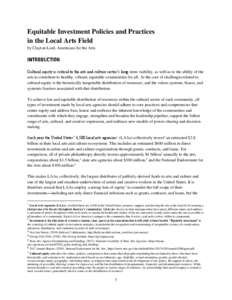
Each year the United States’ 4,500 local arts agencies (LAAs) collectively invest an estimated $2.8 billion in their local arts and culture ecosystems. This includes an estimated $600 million in direct investment in artists and arts and culture organizations through grants, contracts, and loans. For comparison, all of private philanthropy directly invests approximately $4 billion annually to the arts, corporations about $1.5 billion, state arts agencies about $300 million, and the National Endowment for the Arts about $100 million.
This makes LAAs, collectively, the largest distributor of publicly-derived funds to arts and culture and one of the largest and steadiest underwriters of artists and creative workers in the United States. It is therefore crucial that LAAs employ a strong lens of equity7 to consider the full scope of their investments—including not only direct financial infusions such as grants, contracts, and loans, but the estimated $2.2 billion each year that are expended on staff salaries, vendors, direct-to-community programming, overhead, marketing and communications, and more. This is particularly important because the existing systems of power that often drive the policies underlying such expenditures grant privilege and access unequally. With data, will, and guidance, however, progress can be made.
This report reviews results from the 2018 Local Arts Agency Profile, an annual survey deployed in April 2018, with a particular focus on an added module to the survey about how, when, and where LAAs in the United States currently consider equity in the deployment of their funds, time, space, and staff. The data was gathered from a broadly representative sample of 537 local arts agencies in the United States of varying budget size, community size, tax status, geography, etc.
Overall, the report tells a story of a field where direct and indirect practices about and centered on equity are on the rise. While major demographic challenges continue to exist among staff at LAAs of all sizes, the majority of large LAAs, and, in most cases, midsize LAAs as well, are taking a variety of steps to consider, engage, and develop support mechanisms for the full diversity of their communities. LAAs with more limited financial capacity and smaller staff sizes are not able to participate in these new mechanisms at the same rate but are inclined to want to know how they can.
That said, there is significant work to do. Only half of LAAs with DEI-related policies say that those policies affect fiscal decisions. The majority of entry- and mid-level staff do not have access to supported professional development. And, perhaps most starkly, LAA funds are distributed inequitably, with the largest 16 percent of grant recipients receiving 73 percent of the dollars awarded.
Source: Article Abstract
